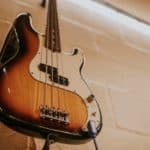A classic rock band involves the following musicians: a singer, a drummer, one to two guitarists, and a bass player.
Some other genres may add a keyboardist, a DJ, or a trumpeter.
You may have noticed that I mentioned two guitars, but only one bass.
You don’t even have to take my word for it. Simply take a look at any band.
Have you ever seen groups with more than one bass player?
Probably a few times, if anything.
The question is, why are bands with two bassists so uncommon?
Bands have one single bassist mainly because of sound preferences. The human ear is not made to comprehend too many low frequencies simultaneously. Therefore, a single bass is more than enough. Although there are ways in which such a combination could work, they tend to be not that common.
There’s so much more to learn about bass here regarding culture, tradition, harmonies, and registers.
You will find all the information below.
Bands with 2 bass players
It is not common to see bands that have two bassists.
Luckily, uncommon is not a synonym of inexistent.
If you are curious by nature and want to listen to bands with two four-string instruments, then check any of the following:
- Dumpstaphunk
- Megachurch
- Godspeed You! Black Emperor
- Cop Shoot Cop
- Dianogah
- Girls Against Boys
- Molotov
With all due respect to both the musicians and the fans, you might have noticed that most of these names are relatively unknown.
That is to say, that there are no “big” or famous bands on the list.
As a result, one could conclude that the popularity of bands with two bass guitars is rather low.
This is not the same as saying that it shouldn’t be done, or that it results in catastrophic performances and unbearable songs.
Still, it is a clear sign of the obscurity and unpopularity of two bassists playing simultaneously.
If that’s the case, then there might be some reasons why…
Why is it uncommon to have more than 1 bassist in a band?
We can come up with two main reasons why bands prefer sticking with just one bass player.
Culture
To enter a band is to face a harsh reality: most musicians don’t want to be bassists!
Everybody yearns to be the lead singer or the guitarist and be the center of attention.
If it is already hard enough to find one willing bassist, then why would you want to look for two!?
Now, jokes aside, there is one important reason to consider.
We may not think about this regularly, but culture, tradition, and the society we live in drastically change the way we behave and the norms we take for granted.
The world of music, too, is influenced by our decisions, which means that if the norm has been to have only one bass player for decades, then it is not going to change from one night to the other.
Take the same concept but change the instrument: why not every band plays with two drums? Why not every band plays with flutes? Why not every band plays with ukuleles?
Because of tradition. And tradition shows that in almost every genre (rock, pop, metal, reggae, ska, hip-hop) a single bassist is more than necessary.
Needless to say, nothing stays the same forever, and those rules can change over time.
However, such change requires a conscious effort and the approval of society for it to survive.
Sound
Honestly, most bands don’t need two basses at all.
Sure enough, some professionals are so good that they manage to make it work.
Truth is, the majority can’t, and there are reasons for it.
Bass guitars are in charge of the “lows”.
Both bass guitars and bass drums create the same range of frequencies.
Such a combination must be clean and easy to listen to.
If it is too complex, then it runs the risk of being hard to hear.
After all, low notes cannot be processed easily by the human ear.
In those conditions, another bass would only make music more unbearable.
As the saying goes: “More isn’t always better”
How could 2 bass guitars work out in a band?
Now, you might think: “Yeah, I get that having two bass guitars in a band is a terrible idea. Then how can there be bands that do it anyway and still sound good?”
Great question!
Different sounds
Both bassists can reach an agreement and see who will play bass as a bass, and who will play bass like a guitar.
It is not impossible. The “guitar-like” bass tone can be done thanks to high distortions and no low ends.
What is more, there’s a limitless amount of pedals and effects that alter the sound.
On the other side of the stage, we have the other bassist, who keeps the low ends and sticks to the root notes, providing a rhythmic bridge between the guitar-like bass and the drums.
Different registers
Two basses could play the same notes but in different pitches, creating a harmony (just like two guitars do).
For this, a piccolo bass would do a wonderful job.
Piccolo basses are the ones that are tuned to higher frequencies (one octave higher, on the most parts).
A band could play both with a standard bass and a piccolo one.
Still, two normal basses can work as well.
Avoiding playing over each other
If we talk about big bands with many musicians, then two bassists could work perfectly.
How? By taking turns!
One of them could play a part of the song, the second one, the other parts.
One, too, could play the main structure while the second plays the solo, for example.
The idea is that the two basses never clash nor play over each other.
It all depends on the ability to think outside the box, and a willingness to have fun and experiment.
Why do 2 guitars work alright in a band, but no 2 basses?
As I previously mentioned, an excessive amount of low frequencies is not comfortable for our ears.
While this is true for bass, electric guitars are a different story.
The midrange of guitars adjusts better to human hearing.
You can observe (or listen to) this by yourself.
Listen to a track that has two guitars playing the exact notes within the exact pitch range.
The output is not dense; it is actually good.
Our nature itself prefers the sound of a double guitar to the sound of a double bass.
Coming back to what we discussed regarding culture and tradition, we could claim that it is generally expected for a band to have two guitars: one for rhythmic parts, the other as a leader in charge of the solos.
Why it is important for bands to keep the low-end crystal clear
Getting a quality low-end is not an easy task.
Too little low-end gets weaker sounds.
Too much of it, and the song sounds muddy and unbearable.
It is important to have a balance, and that balance is generally done with the bass in the middle of the mix.
Low frequencies, as mentioned before, are not the favorite ones for the ear.
Therefore, a musician cannot record three or four different tracks of bass.
On the contrary, adding layers of guitar to the mix can drastically improve a song.
This is because low harmonies clash (which is not the case with guitars).
You may have noticed how inappropriate chords sound in the lowest registers of piano and basses.
All in all, monitoring volume is of paramount importance.
This is not an easy task, and that’s why producers are of such importance to the characteristic sound of an album.

Hello there, my name is Ramiro and I’ve been playing guitar for almost 20 years. I’m obsessed with everything gear-related and I thought it might be worth sharing it. From guitars, pedals, amps, and synths to studio gear and production tips, I hope you find what I post here useful, and I’ll try my best to keep it entertaining also.





